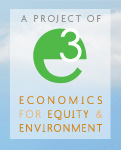by Elizabeth A. Stanton • January 9, 2012 @ 11:11 am
Elizabeth A. Stanton with Ramon Bueno. Orginally posted on the Climate & Development and Knowledge Network Blog.
Greenhouse gas emissions are a global problem. Regardless of who emits them, these gases impact everyone, everywhere around the world: raising average temperatures and sea levels, and changing historical weather patterns. But climate change will not affect everyone equally. The two dozen island nations of the Caribbean are a case in point. With 40 million people living on islands in a small geographic area, it would be easy – but incorrect – to expect that they will all face the same climate damages. In fact, according to new research from the Stockholm Environment Institute (SEI), Caribbean residents are not all “in the same boat” and should expect to face a very wide diversity of climate impacts.
Yes, each person living in the Caribbean will experience about the same change in climate – temperature increase and shift in weather patterns – and degree of sea-level rise as her neighbors over the next decades. And her children and grandchildren can expect about the same changes to weather and sea levels as their neighbors. But these changes in the physical world will not impact all Caribbean residents in the same way.
SEI’s new Climate Impact Equity Lens (SEI-CIEL, see www.sei-ciel.org for more information) examines the diverse impacts of climate change by zooming in on four important types of diversity that affect individuals’ expected impacts from climate change: family income; share of income from economic sectors that are especially vulnerable to damages from climate change; exposure to sea-level rise and storm surge; and present-day water availability.
Family income plays an important role in who will be vulnerable to damages and who can afford to adapt as the climate changes. The Caribbean islands include the countries with the highest and lowest average incomes in the greater Latin American and Caribbean region: in Haiti, the average person makes less than US$500 a year (but, of course, some people make a lot more than $500 and some people make a lot less); in the Cayman islands, the average income is $52,000. The Caribbean islands account for less than 1 percent of global population, but Caribbean incomes span the same diversity as world incomes: from the very poorest to the very richest. Families making a few hundred U.S. dollars each year can scarcely afford basic living expenses much less investments in air conditioning, sea walls, or imported water. The richest families, in contrast, can afford these investments and much more; it seems unlikely that the very rich will experience much real suffering from climate change.
The diversity of climate impacts is also affected by the source of income. For those that work in agriculture, fisheries, tourism, or other sectors or industries especially vulnerable to climate change, expected damages are much higher. Tourism, for example, contributes about half of all income in Aruba, Netherlands Antilles, Saint Lucia, and Turks and Caicos, and far more than half of all income for many households throughout the Caribbean.
Physical vulnerabilities like exposure to sea-level rise and water scarcity also vary throughout the region. Some families live close to the shoreline, at low elevations, or in floodplains, but many others – especially on the largest islands, Puerto Rico, Cuba, and Hispaniola (Haiti and the Dominican Republic) – are well protected from the first several meters of sea-level rise. On most Caribbean islands, fresh water is a scarce resource, but on a few islands water resources are more abundant. Climate change is expected to make many of the most arid areas around the world even drier; where present-day water scarcity is severe, families are more vulnerable to changing weather patterns.
The SEI-CIEL model finds that, if greenhouse gas emissions continue, climate damages for the average person in Latin America and the Caribbean would equal “savings” from not paying to reduce emissions through about 2100. (If emissions are not controlled, we all “save” by paying lower energy costs.) This average does not, however, represent the diversity of individual impacts from climate change expected in the Caribbean, where damages for many individuals will outstrip “savings” by 2050, and by 2100, most people experience net damages.
If policy makers pay attention only to the average regional result, their conclusions about the urgency of climate change would be very different than if they consider the diversity of individual impacts. Many people, in the Caribbean and around the world, will experience serious net damages from climate change by 2050. Those who care about the well-being of the most vulnerable will press climate policy makers to slow emissions as quickly as possible.

